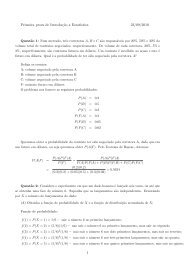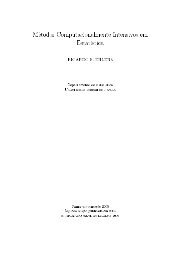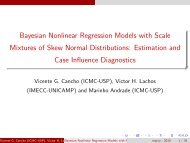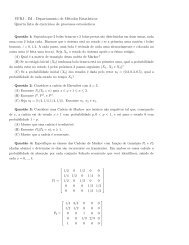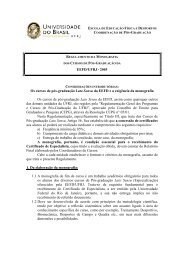Copulas: a Review and Recent Developments (2007)
Copulas: a Review and Recent Developments (2007)
Copulas: a Review and Recent Developments (2007)
Create successful ePaper yourself
Turn your PDF publications into a flip-book with our unique Google optimized e-Paper software.
Table 1: Distribution of (C 1 jC 2 )(t), Nelsen et al. (2001a).C 1 =C 2 min(u; v) ¦=uv max(u + v ¡ 1; 0)min(u; v) t 2t ¡ t 2 min(2t; 1)p p¦=uvt t(1 ¡ lnt) 1 ¡ max(0; 1 ¡ 4t)max(u + v ¡ 1; 0) 0:5(t +1) 1 ¡ 0:5(1 ¡ t) 2 1Thus, for example, (min(u; v)jmin(u; v)) » U(0; 1); (min(u; v)juv) » Beta(1; 2);(min(u; v)jmax(u + v ¡ 1; 0)) » U(0; 0:5); the distribution of (uvjmin(u; v)) »Beta(0:5; 1); (max(u + v ¡ 1; 0)jmax(u + v ¡ 1; 0)) is a degenerated one, etc.If we assume additionally that the copulas C 1 <strong>and</strong> C 2 coincide, i.e. C 1 = C 2 = C,we obtain the Kendall distribution function, see Nelsen et al. (2003). If X <strong>and</strong> Y havejoin distribution function H, the Kendall distribution function of (X; Y ), to denoteit by K C , depends only on the copula C associated to H, i.e.for any t 2 [0; 1]. Formally, we haveK C (t) =P (H(X; Y ) · t) =P (C(U; V ) · t)K C (t) =¹ Hµ ©(x;y) 2 (¡1; 1)2¯¯H(x; y) · tª = ¹ Cµ ©(u;v) 2 [0; 1]2¯¯C(u; v) · tª :From Table 1, for example, one can see that only in the comonotonic case wehave K min(u;v) (t) =t, i.e. K min(u;v) » U(0; 1); K uv (t) =t(1 ¡ lnt), (which is thedistribution of the product of two U(0; 1) variates), when C is presented by theindependence copula <strong>and</strong> K max(u+v¡1;0) (t) = 1 in the countermonotonic case.In fact, Kendall distribution function is an one-dimensional summary of underlyingdependence structure of (X; Y ). We will use it again in Section 3.2.2.1.2 Grade transformation version of Sklar's theoremHere we discuss the grade transformation which, being an extension of probabilityintegral transform, enables unique copula representation of a multivariate distributionof any type for which the marginal distributions can be de¯ned.As we discussed already in Introduction, one-dimensional margins of a continuousmultivariate distribution are transformed by their distribution functions then oneobtains a copula (n-copula) determined by a joint distribution in a unit square [0; 1] 2(or n-cube [0; 1] n ) with margins having U(0; 1) distribution. It is also well known thatsuch property does not hold in a discrete case. Indeed, if the discrete r<strong>and</strong>om variableX takes values x 1




